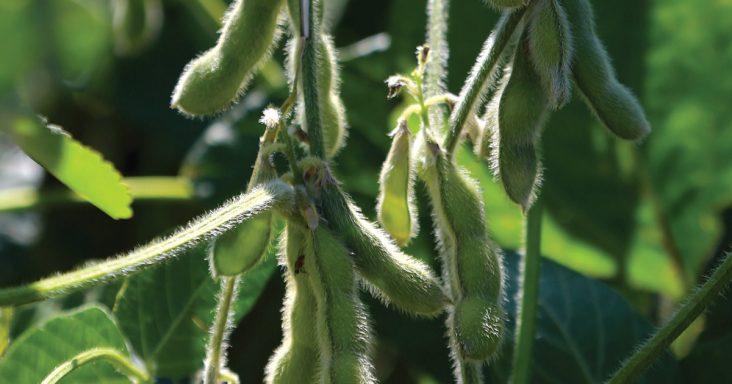Arkansas row crop farmers will work to ‘recover’ lost acres in 2020
by February 24, 2020 6:12 pm 1,505 views

The second half of the 2010s were a bleak time for many Arkansas farmers. Commodity prices were depressed and ongoing trade wars with China, Mexico, and other countries reduced market shares for producers in the Natural State. Add to that a series of devastating weather events and it’s no wonder crop acres for some crops, particularly soybeans, fell precipitously.
Soybean farmers dropped their acres by 600,000 to 2.6 million in 2019, after years of remaining above the 3 million acre mark, according to the U.S. Department of Agriculture’s National Agriculture Statistics Service (NASS). It was the lowest number of acres since 1960.
University of Arkansas at Monticello agriculture economist Dr. Robert Stark Jr. told Talk Business & Politics he doesn’t think the state’s top row crop will return to 3 million acres in 2020, but he is optimistic that more soybean acres will be planted in 2020.
“My personal opinion is that we will recover some of those lost acres. I don’t think we will quickly move back to 3 million plus acres we’ve had in the past. I think it will take awhile to reach those totals,” he said.
The U.S. economy is projected to slow as the decade begins, and that could reduce consumption of agriculture commodities, but the USDA is projecting that 84 million soybean acres will be planted in the country this year, the fourth largest crop on record and a nearly 10% increase from the previous year. Prices for the crop could be slightly higher than last year. The National Soybean Index reported the average price at $8.85 per bushel, and some projections indicate that price could climb to around or above $9 per bushel at times during the next growing season.
In Arkansas, the opening per bushel cash price was slightly higher than the national averages at $9.29, according to the new crop booking market. Those prices would be slightly higher than in the 2018 and 2019 growing seasons. Stark said there are several factors that could lead to soybean growth in the coming year. China, the largest importer of soybeans in the world, has been in a nearly two year long trade war with the U.S. that will likely end this year, and the Chinese have already loosened some tariffs on the crop that is primarily used to feed livestock in the country.
Demand for soybeans has been on the decline during the last year as a deadly bout of African swine fever swept parts of southeast Asia and Europe. An estimated 200 million pigs could have been lost during the epidemic. At some point, Stark said, there will be an attempt to re-establish those herds, and that should drive demand for livestock feed.
There has been a proactive push by Arkansas farmers to increase storage capacity on farms, and Stark said he thinks that will help farmers regulate better profit margins. For instance, if prices are lower, a farmer might just store and dry his crop for a few months to allow the markets to improve, he said.
With soybeans acres still in flux in 2020, other crops could experience gains. Arkansas is the leading rice producer in the country, growing roughly half the domestic supply. During the past two years, the number of rice acres has increased and prices have steadily climbed. Arkansas increased from about 12.4 million hundredweight to about 22.9 million hundredweight. Scott Stiles, extension economist for the University of Arkansas System Division of Agriculture, said the change reflects both the size of the crops, year-to-year, as well as market prices. As the new year opens, cash prices for rice were $12.10 per cwt, according to USDA.
Although estimates for rice acres haven’t yet been formulated, the projected global rice market is predicted to expand slightly this year, which could trickle down to domestic farmers growing more rice. In 2019, an estimated 177.8 million tons of rice was exported to international markets, and that number could jump to near 180 million tons this year, USDA reported.
Arkansas farmers planted 810,000 corn acres in 2019, the second most on record. It’s uncertain, however, if that acreage will increase even though national production is projected to hit 94 million acres — a near record. But a lot of that could be due to the uncertainty in other markets such as soybeans, Stark added. Corn bushel prices opened 2020 relatively low. Corn was trading at $3.87 per bushel, well below the five year high of $4.54 in June of 2019.
There’s no doubt commodity prices, weather, trade wars and other factors will impact farmers during this growing season, Stark said. One thing he doesn’t expect is for farmers to not farm acres or let usable fields sit fallow. Conditions haven’t been favorable for producers, but he doesn’t expect any significant drops in the number of acres farmed in Arkansas in 2020.
“I don’t anticipate farmers leaving fields fallow … if anything I think they’ll push harder to recoup losses from the previous years,” he said.
Editor’s note: This article first appeared in Talk Business & Politics annual State of the State magazine.
